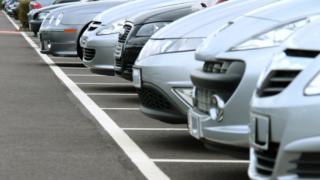 Image copyright
Getty Images
Image copyright
Getty Images
Motorists who drive to work could have to pay hundreds of pounds a year for a parking space under proposals in this year's Scottish budget.
The budget deal agreed between the Scottish government and Scottish Greens will allow councils to introduce a workplace parking levy (WPL).
This would see employers pay an annual tax to the council for every parking space they provide for employees.
Employers could then choose whether to pass on the cost to their staff.
Environmental groups believe the initiative will help reduce congestion and air pollution in the country's towns and cities by encouraging motorists to walk, cycle or take public transport to work, as well as raising money for local services.
But opponents say it will simply hit businesses and workers in the pocket - and are sceptical about whether people really will choose to ditch their cars.
What are the proposals anyway?
The minority SNP government announced on Thursday that it had reached a deal that will see the Scottish Greens back its budget proposals.
As part of the agreement, the government has pledged to allow councils to introduce a WPL if they want to do so.
This will be done by amending the Transport (Scotland) Bill that is currently going through the Scottish Parliament.
With both the SNP and Greens backing the amendment, it is almost certain to pass and become law - although the government has stressed that NHS workers will not have to pay the levy.
How will it work?
Calls for a tax on workplace parking in Scotland have largely been inspired by a scheme that was introduced in Nottingham in 2012 as part of efforts to reduce traffic congestion in the city.
It had been estimated that commuters driving to and from work accounted for about 70% of peak time traffic in Nottingham.
The Nottingham model sees employers who provide more than 10 parking spaces for their staff pay about £400 every year to the city council for each space, with the charge increasing each year in line with inflation.
Some employers choose to foot the bill themselves - while others pass on some or all of the cost to workers.
The tax has raised about £9m a year since it started, with the money required by law to be spent on sustainable transport projects.
So far, it has helped to pay for an expansion to the city's tram network and a redevelopment of its main railway station, as well as supporting its fully-electric park-and-ride bus network and the Robin Hood integrated travel smartcard.
Staff parking at hospitals and other NHS premises is exempt from the charge, as are disabled parking spaces and front line emergency services such as the ambulance, police and fire services.
The charge also does not apply to parking spaces for motorbikes, customer vehicles, fleet vehicles that are parked at an employer's premise but are not used to travel to and from work, or vehicles that are used to deliver and collect goods.
What are the benefits?
Supporters of a workplace parking tax say it has helped to reduce congestion in Nottingham alongside the improvements to public transport that the scheme has helped to pay for.
It has been predicted that the improvements will take the equivalent of 2.5 million car journeys off the city's roads each year, cutting pollution and carbon emissions as well as reducing travel times for people who do still use their cars.
Public transport is said to now account for more than 40% of journeys in Nottingham, with the city also reported to be the only one in England to have seen a reduction in road journey times during rush hour.
The Nottingham tax is enforceable by law but is said to have had 100% compliance from local employers since it was introduced - and to be very cheap and easy to manage.
Alex Quayle, of Sustainable Transport Scotland, said the Nottingham scheme had clearly been very successful in encouraging people to change their commuting habits.
He told the BBC's Good Morning Scotland programme: "Nottingham has seen a reduction in congestion and they've also seen revenue raised to invest in sustainable transport, trams, buses and better provision for walking and cycling.
"That means that people who can walk or cycle or get public transport have a better service to do so, so it does cut congestion by people changing how they travel."
But not everyone is happy?
Critics argue that many people - for example parents who drop their kids off at school as part of their morning commute - are simply unable to get public transport to work, far less walk or cycle.
Motoring journalist Alan Douglas argued that it was therefore "nonsense" to suggest that people would change their habits, and that the vast majority would just "bite the bullet and pay".
He added: "What we need to get people out of their cars - if we want to get people out of their cars - is to provide better public transport.
"The fact is people use their cars because the public transport is not there, and we have seen from the problems with ScotRail that people would want to use it but they can't depend on it so they use their cars as the best alternative."